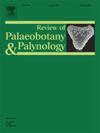Shanxioxylon yangquanense sp. nov., a new Kasimovian cordaitalean axis from the Benxi Formation (Pennsylvanian, Carboniferous) of Yangquan City, Shanxi Province, North China
IF 1.7
3区 地球科学
Q2 PALEONTOLOGY
引用次数: 0
Abstract
A new Kasimovian cordaitalean fossil axis, Shanxioxylon yangquanense sp. nov., is described from the Pennsylvanian Benxi Formation of Yangquan City, Shanxi Province, North China. The axis is composed of the pith, primary xylem, secondary xylem, phloem and cortex. The pith is septate or hollow, heterogeneous, with parenchyma cells and spherical secretory cavities distributed at the periphery. Cauline bundles are endarch. Leaf traces are mesarch, mostly diverging from pith margin as single bundle. Double leaf traces are present occasionally. The secondary xylem is pycnoxylic, featured by dominantly araucarian uniseriate radial tracheid pits and cupressoid cross-field pitting. The fossil axis represents the third and oldest species of Shanxioxylon (Tian et Wang) Wang et al. from the upper Paleozoic of Cathaysia, indicating that this endemic cordaitalean genus had evolved by at least the Kasimovian in North China. Shanxioxylon yangquanense sp. nov. is proposed to have lived as an arborescent form in the clastic wetland of stream riparian zones under a perhumid climate based on its great morphological and anatomical similarities to Agathoxylon leei (Sze) Wang et Wan from the same fossil interval.
山西阳泉市石炭系宾西法尼亚系本溪组一条新的卡西莫瓦-寒带轴Shanxioxylon yangquanense sp. nov.
在山西阳泉市宾西法尼亚系本溪组中发现了一条新的卡西莫期寒武纪化石轴Shanxioxylon yangquanense sp. nov.。轴由髓、初生木质部、次生木质部、韧皮部和皮层组成。髓是分隔的或中空的,不均匀,周围有薄壁细胞和球形分泌腔分布。茎束是内生的。叶迹为串珠状,多数从髓缘发散成单束。偶有双叶痕迹。次生木质部为紧实木质部,以单元生的放射状管胞凹陷和柏木状的交叉凹陷为主要特征。化石轴代表华夏上古生界Shanxioxylon (Tian et Wang) Wang等人发现的第三种也是最古老的一种,表明这一特有的珊瑚属至少在华北地区的Kasimovian时期就已经进化了。Shanxioxylon yangquanense sp. 11 .与同一化石段的Agathoxylon leei (Sze) Wang et Wan在形态和解剖上有很大的相似之处,认为其以树状形态生活在过湿润气候下的河流河岸带碎屑湿地中。
本文章由计算机程序翻译,如有差异,请以英文原文为准。
求助全文
约1分钟内获得全文
求助全文
来源期刊
CiteScore
3.50
自引率
21.10%
发文量
149
审稿时长
6 months
期刊介绍:
The Review of Palaeobotany and Palynology is an international journal for articles in all fields of palaeobotany and palynology dealing with all groups, ranging from marine palynomorphs to higher land plants. Original contributions and comprehensive review papers should appeal to an international audience. Typical topics include but are not restricted to systematics, evolution, palaeobiology, palaeoecology, biostratigraphy, biochronology, palaeoclimatology, paleogeography, taphonomy, palaeoenvironmental reconstructions, vegetation history, and practical applications of palaeobotany and palynology, e.g. in coal and petroleum geology and archaeology. The journal especially encourages the publication of articles in which palaeobotany and palynology are applied for solving fundamental geological and biological problems as well as innovative and interdisciplinary approaches.

 求助内容:
求助内容: 应助结果提醒方式:
应助结果提醒方式:


